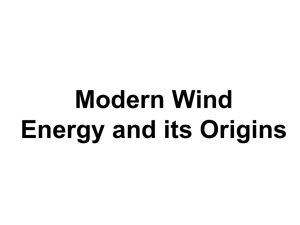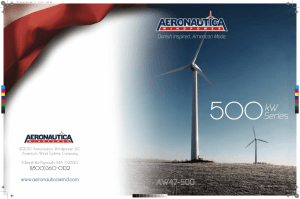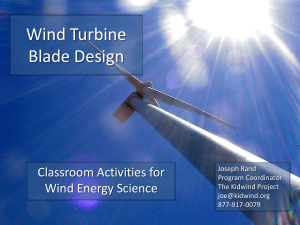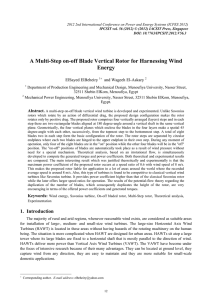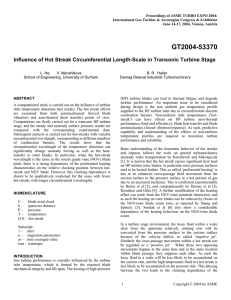Test 2060
advertisement
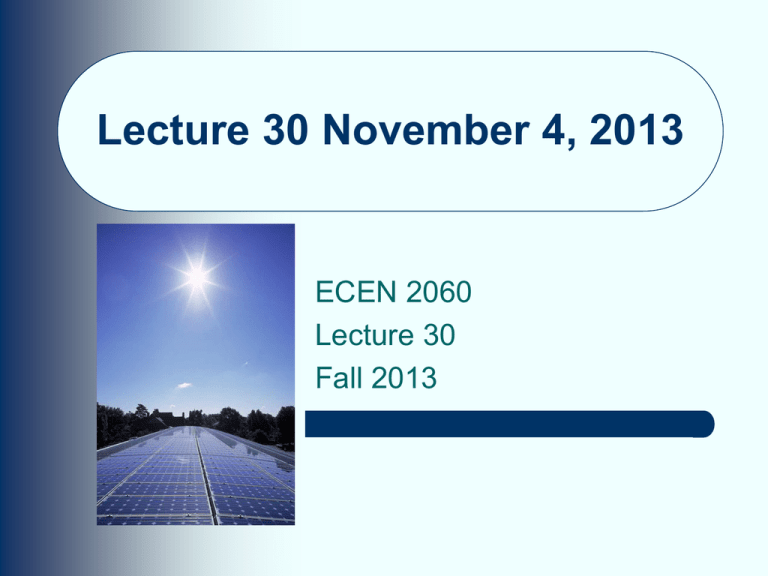
Lecture 30 November 4, 2013 ECEN 2060 Lecture 30 Fall 2013 Wind Power Systems • 1. Windmills go back a long time. A key money maker for milling grain. • 2. First use for electrical generation in 1891 by Poul la Cour used generate hydrogen. • 3. Used shortly afterward in the rural US. • 4. 1941 Grand Paw’s Knob Vermont 1250 kW,175ft two blade system. Failed in 1945 • 5. 1970’s to mid 1980’s in California and then to Europe ECEN2060 2 Rapid Grow of Wind Capacity ECEN2060 3 World Wide Growth of Wind Energy ECEN2060 4 Fraction of Total Generation by Wind ECEN2060 5 Data on Wind ECEN2060 6 Types of Wind Turbines ECEN2060 7 Characteristics of Some Wind Turbines • 1. Horizontal Axis Wind turbine Up wind and Down wind. A. Down wind has advantage of self aligning (yaw) B. Disadvantages Shadowing by tower that increases flexing of the blades which, decrease power, increases fatigue and noise. C. Up wind Advantage More power, Smoother D. Disadvantages more complicated control • 2. Vertical Axis, Darrieus • Advantage Heavy equipment on the ground. Lighter tower. • Disadvantage Blades close to the ground where the wind is slower. Low starting torques. Hard to feather in high winds. ECEN2060 8 Schematic for Horizontal Wind ECEN2060 9 Wind Turbine Gear Box ECEN2060 10 Area of Capture ECEN2060 11 Wind Turbines • Most wind turbines are up wind horizontal. • Many blades high torque and works well at low wind speeds. • Two blades turn faster than 3 blades, less turbulence. 3 blades smoother and installed the most. 3 blade weights more. ECEN2060 12 Pitch Angle Controls Lift, Speed and Power ECEN2060 13 High Pitch Can Lead to Stall ECEN2060 14 Wind is Slowed by Blades •1 ECEN2060 15 Wind Power ECEN2060 16 Wind Power ECEN2060 17 Area of Darrieus ECEN2060 18 Lecture 31 November 6, 2013 ECEN2060 19 Temperature Correction for Air Density The molecular weight of air is approximately 28.97 and the density at 15o C is 1.225 kg/m3 ECEN2060 20 Dry Air Pressure at 1Atmosphere ECEN2060 21 Altitude Correction ECEN2060 22 Table of Air Pressure with Corrections for Temperature and Altitude. •. ECEN2060 23 Effects of Tower Height Z is the roughness length ECEN2060 24 Surface Friction ECEN2060 25 Roughness ECEN2060 26 Effects of Height with Different Roughness ECEN2060 27 Effects of Variation of Wind Speed with Height on Stress This leads to vibrations, noise, blade flexing and fatigue. Factors to 1.45 more power at top to bottom in example. ECEN2060 28 Maximum Rotor Efficiency Betz limit 1/3 initial velocity ECEN2060 29 Blade Efficiency Assume uniform velocity over the blade To find the maximum power efficiency ECEN2060 30 Real Turbines 1 Best 80% of Betz limit more often 40% to 50% 2. Depends on ratio of rotor speed to wind speed. Often defined in terms of Tip speed. ECEN2060 31 Blade Efficiency ECEN2060 32 Efficiency for Different Blade Systems ECEN2060 33 Idealized Operating Power Curve ECEN2060 34 Matching Generator Size to Rotor Diameter with Wind Speed •1 ECEN2060 35 Blade Speed Limits • 1. Want to operate in the TSR of 4-6 • 2. Example 40m blades 600kW ,14m/s, This leads to 26 revolutions per minute and tip speed of 56m/s • 3. Required gear ratio to get to 1800rpm of 67.4 • 4. Wind Power of 2,112 kW to get 600kW or an efficiency of 28% ECEN2060 36 Some Real Turbines •1 ECEN2060 37 Efficiency and Power for Some Turbines ECEN2060 38 Average Wind Speed Classifications ECEN2060 39 Wind Speed Measurements ECEN2060 40 Types of Generators • 1. Synchronous Generators A. Fixed Speed Rotational speed N(rpm) = 120𝑝 𝑓 p = number of poles f = frequency for a three phase winding. 2. Induction Generators These generators have slip between the rotor speed and the speed of the rotating field in the stator. ECEN2060 41 Generators for Wind Turbines • 1. A key issue is the variable of the wind speed and a need for nearly constant speed to achieve 50 or 60hz. • 2. Basic equations • F= q(E + vxB) = qE + I xB and Vinduced = - B ds = - d ~ I t dt 3. Note the current I is proportional to the rate of change of the magnetic field B and the force is proportional to the product B ∂B/∂t 3. Synchronous Generators A. Need for constant speed to keep output at 60hz. 4. Induction Generators ECEN2060 42 Types of Systems ECEN2060 43 Synchronous Generator ECEN2060 44 A Direct Drive Permeate Magnetic Machine •1 ECEN2060 45 Induction Generator • 1.Fixed windings on the rotor and does not require brushes or electrical contact with the rotor. • 2. The rotor runs a little slower than the rotating field when operating as a motor and faster when it is working as a generator. • 3. The induced current in the rotor conductors generate the magnetic fields that lead to the torques. ECEN2060 46 Forces with a Rotating Magnetic Field ECEN2060 47 Squirrel Cage Rotor Note 3 phase driving current gives a rotating field when the currents are 120 degrees out of phase Synchronous speed Ns = 120 f/p where f is the frequency and p Is the number of poles. ECEN2060 48 Squirrel Cage Rotor ECEN2060 49 Rotating Magnetic Fields ECEN2060 50 Induction Motor Torque –Slip Curve ECEN2060 51 Example of Induction Motor. ECEN2060 52 Inductance Machine as Generator 1. The wind starts the machine as a motor until it gets above synchronous speed 2. Can be connected to the grid or self excited with a capacitor and remnant magnetic field. Set it to resonate with the Stator Inductance ECEN2060 53 Need for Speed Control • 1. Want to operate with a tip speed ratio of 4-6 for maximum power and blade efficiency Cp • 2. If direct connection to the grid need a fixed blade speed for phase and frequency control to match frequency on the grid if you have a fixed turbine to generator connection. • 3. Need to shed power in high winds. 4. Use a gear box. • 5. Use pitch control of the blades • 6. Control of slip which in turn controls power. • 7. Doubly wound rotor. ECEN2060 54 Inductance Generator Speed Control ECEN2060 55 Examples of Speed Adjustments. ECEN2060 56 Control of the Number of Poles in the Stator • 1. This can be done by changing the connections on the windings. For example two poles adjacent to each other can be connected to look like one. This is 1/2 the frequency for a fixed speed. • 2. Change gear ratio. • 3. Varying the resistance seen by the rotor winding varies the slip. • 4. Use an indirect connection to the grid by way of an inverter AC to DC to AC(60hz.) This allows for variable frequency into the inverter and variable turbine speed. ECEN2060 57 Variable Speed Turbine and Indirect Connection to the Grid ECEN2060 58 Doubly Wound Induction Machine ECEN2060 59 Gearless Drive •1 ECEN2060 60 Average Wind Power This is the wind turbine owners get paid. Note there is a big difference between V average and V3average ECEN2060 61 A wind speed histogram ECEN2060 62 A Probability Density Function ECEN2060 63 Weibull and Rayleigh Functions ECEN2060 64 Weibull Density Functions ECEN2060 65 The Rayleigh Probability Density Function ECEN2060 66 Rayleigh Distribution ECEN2060 67 Some Real Data ECEN2060 68 Midwest Wind ECEN2060 69 ECEN2060 70 ECEN2060 71 Wind Turbine Gear Box ECEN2060 72 ECEN2060 73


